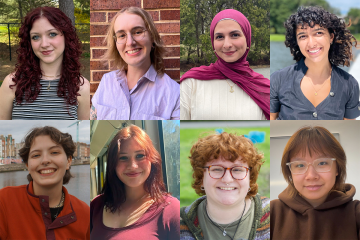Dr. John Young is a developmental biologist. The students in his lab use frogs to understand how changes in development can form the basis of the many forms seen in nature. He teaches courses that focus on development, stem cells, and biological diversity.
Education
- PhD, University of California, Berkeley
- MS, University of Oregon
- BS, Aquinas College
Courses
- BIOL 113 General Biology
- BIO 218 Organismal Diversity in the Environment
- BIO 333 Marine Biology
- BIOL 335 Developmental Biology
- BIO 347 Human Development and Genetics
Research/Special Projects
Have you ever wondered where your arms and legs come from? Or how did you make your brain? Broadly, our lab seeks to answer these questions using the model system Xenopus laevis, a widely used frog from South Africa.
Neural patterning in the early embryo
The formation of the central nervous system is a key event in the development of vertebrates. In the lab, we use genome-editing methods to investigate the genetic mechanisms that direct the brain and spinal cord to develop in the correct anatomical position.
Limb formation in amphibians
Humans form their arms and legs in early embryogenesis. Conversely, most amphibians form them during metamorphosis. While we have a good understanding of limb development in birds and mammals, very little is known about how this process occurs in amphibians. We use various molecular, genetic, and embryological techniques to understand where frog limbs come from and how they are generated.
Publications
Young, J. J. (2023). In preprints: of genitalia and six-legged mice. Development (Cambridge) 150
Clancy, M.*, Wade, I.S.**, Young, J.J., 2023. Facile methods for reusing laboratory plastic in developmental biology experiments. Differentiation 130, 1–6. https://doi.org/10.1016/J.DIFF.2022.11.001
Royle, S.R. and Young, J.J., 2021. A 5’HoxD-Gli3 balance in tetrapod axial polarity. Curr. Biol. 22, R1487-R1490.
Royle, S.R., Tabin, C.J., Young, J.J., 2021. Limb positioning and initiation: An evolutionary context of pattern and formation. Dev. Dyn. doi:10.1002/dvdy.308
Kong, N.R., Bassal, M.A., Tan, H.K., Kurland, J.V., Yong, K.J., Young, J.J., Yang, Y., Li, F., Lee, J.D., Liu, Y., Wu, C.-S., Stein, A., Luo, H.R., Silberstein, L.E., Bulyk, M.L., Tenen, D.G., Chai, L., 2021. Zinc Finger Protein SALL4 Functions through an AT-Rich Motif to Regulate Gene Expression. Cell Rep 34, 108574. doi:10.1016/j.celrep.2020.108574
Young, J.J., Grayson, P., Edwards, S.V., Tabin, C.J., 2019. Attenuated Fgf Signaling Underlies the Forelimb Heterochrony in the Emu Dromaius novaehollandiae. Current Biology 29, 3681–3691.e5.
Young, J.J., Grayson, P., Tabin, C.J., 2019. Developmental Biology: Hox Timing Determines Limb Placement. Current Biology 29, R52–R54.
Young, J.J., Tabin, C.J., 2017. Saunders's framework for understanding limb development as a platform for investigating limb evolution. Developmental Biology 429, 401-408.
Young, J.J., Kjolby, R.A.S., Wu, G., Wong, D., Hsu, S.-W., Harland, R.M., 2017. Noggin is required for first pharyngeal arch differentiation in the frog Xenopus tropicalis. Developmental Biology 426, 245-254.
Uygur, A., Young, J., Huycke, T.R., Koska, M., Briscoe, J., Tabin, C.J., 2016. Scaling Pattern to Variations in Size during Development of the Vertebrate Neural Tube. Developmental Cell 37, 127–135.
Young, J.J., Kjolby, R.A.S., Kong, N.R., Monica, S.D., Harland, R.M., 2014. Spalt-like 4 promotes posterior neural fates via repression of pou5f3 family members in Xenopus. Development 141, 1683–1693.
Young, J.J., Cherone, J.M., Doyon, Y., Ankoudinova, I., Faraji, F.M., Lee, A.H., Ngo, C., Guschin, D.Y., Paschon, D.E., Miller, J.C., Zhang, L., Rebar, E.J., Gregory, P.D., Urnov, F.D., Harland, R.M., Zeitler, B., 2011. Efficient targeted gene disruption in the soma and germ line of the frog Xenopus tropicalis using engineered zinc-finger nucleases. Proceedings of the National Academy of Sciences USA 108, 7052–7057.
Stolfi, A., Gainous, T. B., Young, J. J., Mori, A., Levine, M., and Christiaen, L. (2010). Early chordate origins of the vertebrate second heart field. Science 329, 565-8.
Ding, Y., Boguslawski, E. A., Berghuis, B. D., Young, J. J., Zhang, Z., Hardy, K., Furge, K., Kort, E., Frankel, A. E., Hay, R. V., Resau, J. H., and Duesbery, N. S. (2008). Mitogen-activated protein kinase kinase signaling promotes growth and vascularization of fibrosarcoma. Mol Cancer Ther 7, 648-58.
Depeille, P., Young, J. J., Boguslawski, E. A., Berghuis, B. D., Kort, E. J., Resau, J. H., Frankel, A. E., and Duesbery, N. S. (2007). Anthrax lethal toxin inhibits growth of and vascular endothelial growth factor release from endothelial cells expressing the human herpes virus 8 viral G protein coupled receptor. Clin Cancer Res 13, 5926-34.
Young, J. J., Bromberg-White, J. L., Zylstra, C., Church, J. T*., Boguslawski, E., Resau, J. H., Williams, B. O., and Duesbery, N. S. (2007). LRP5 and LRP6 are not required for protective antigen-mediated internalization or lethality of anthrax lethal toxin. PLoS Pathog 3, e27.
Presentations
Limb development and initiation in Xenopus, Cell and Developmental Biology of Xenopus, Cold Spring Harbor Laboratories course, Cold Spring Harbor, NY (April 2024)
Insights into the mechanism of hind limb induction in Xenopus laevis, Morphogenesis Seminar Series, Department of Physiology, Development, and Neuroscience, University of Cambridge, UK (February 2024)
Amphibian limb development is a combination of teleost and amniote mechanisms, Embryology Course lecture, Marine Biological Laboratory, Woods Hole, MA (June 2023)
Limb development and evolution in tetrapods, Embryology Course lecture, Marine Biological Laboratory, Woods Hole, MA (June 2022)
Forelimbs, Flight and Froglegs, Evo-Devo Seminar, Union College, Schenectady NY (February 2022)
Heterochrony in limb development in avians and anurans, Current Topics in Evolution and Zoology Seminar, University of Basil, Basil, CH (November 2021)
Forelimbs, Flight and Froglegs, Embryology Course lecture, Marine Biological Laboratory, Woods Hole, MA (June 2021)
Professional Affiliations & Memberships
- Society for Developmental Biology


